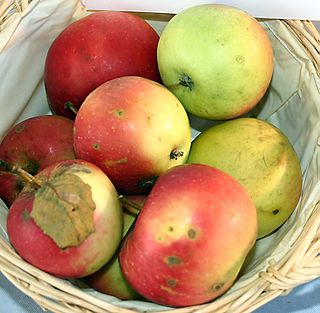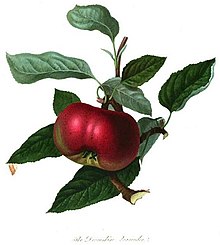
Cox's Orange Pippin, in Britain often referred to simply as Cox, is an apple cultivar first grown in 1825 or 1830 at Colnbrook in Buckinghamshire, England, by the retired brewer and horticulturist Richard Cox.

The damson, damson plum, or damascene, is an edible drupaceous fruit, a subspecies of the plum tree. Varieties of insititia are found across Europe, but the name damson is derived from and most commonly applied to forms that are native to Great Britain. Damsons are small, ovoid, plum-like fruit with a distinctive, somewhat astringent taste, and are widely used for culinary purposes, particularly in fruit preserves and jams.

Jonathan is a medium-sized sweet apple, with a touch of acid and a tough but smooth skin, good for eating fresh and for cooking. Parentage = Esopus Spitzenburg x ?

A pearmain, also formerly spelled "permain", is a type of apple. The name may once have been applied to a particular variety of apple that kept well, although in more modern times its inclusion in varietal names was, like the term 'Pippin', "largely decoration" rather than indicating any shared qualities.

Ashmead's Kernel is a triploid cultivar of apple. Traditionally, Ashmead's Kernel was thought to be diploid but a poor pollinator.

Claygate Pearmain is an apple cultivar. It was found at Claygate, Surrey in England and brought to the attention of the Royal Horticultural Society by John Braddick in 1821. The apple was a popular eating apple in Victorian times and spread through England and to America.

The Kingston Black, also known as Black Taunton, is a cultivar of apple originating from the United Kingdom and used in making cider. The name of the cultivar comes from the apples' dark red or purplish skin, though despite the name, the fruit does not have a black hue.

'Discovery' is an early season dessert apple cultivar. One of its parents was the 'Worcester Pearmain', with the pollinator 'Beauty of Bath'.
'Brown Snout' is a 19th-century cultivar of cider apple originating in Herefordshire in the United Kingdom, though now grown in other counties and parts of the world.

The Foxwhelp is a very old cider apple cultivar, originating in the west Midlands of England.

'Akane', also known as 'Tokyo Rose', 'Tohoku No.3' and 'Prime Red', is a Japanese cultivar of domesticated apple, that according to Orange Pippin is one of the best early season apples.

'Worcester Pearmain' is an early season English cultivar of domesticated apple, that was developed in Worcester, England, by a Mr. Hale of Swanpool in 1874. It was once the most popular cultivar in England for early autumn harvest and is still popular to keep in the garden. It has been extensively used in apple breeding.

King of the Pippins or Reine des Reinettes (French), Goldparmäne, Wintergoldparmäne (German) is an old cultivar of domesticated apple originating from France, and is still used in its original form as well as in many derivative cultivars that have been bred from it. It was also formerly known as Golden Winter Pearmain, because of its ripening period at late fall.

Winston is an English cultivar of domesticated apple which was first named Winter King because of its availability in the winter, but was renamed as Winston in 1944 or in 1945, after Winston Churchill.

'Tom Putt' is a traditional variety of dual purpose apple, often used as a cider apple, originating in Devon. It was also known as Ploughman, Coalbrook, Marrowbone, Thomas Jeffreys and by many other local names.

Slack-ma-Girdle is an old variety of cider apple formerly widely grown in the South-West of England. It is one of a group of similar and closely related varieties all often known by the name "Woodbine".

The Woodcock was one of the oldest described English varieties of cider apple. It originated in the West of England in the counties of Herefordshire and Gloucestershire.
The Coccagee, also spelt 'Cackagee' or 'Cockagee' and sometimes known as the 'Irish Crab' or 'Lord Cork's Crab', is or was a variety of cider apple, known in Ireland and the West of England.

The Lady is a historic apple cultivar originating in Brittany, France in at least 1628. The cultivar has gained a variety of known names in English, and is commonly referred to as Api or the Lady Apple. As a seedling, the apple has the names Helen and Highland Beauty. The cultivar is known for its miniature "tiny" size, generally less than 2 inches in diameter. Its harvest time is late August and September within the Southern United States and later in higher elevations and attitudes, up to late October and early November. They are used for "dessert, cooking, cider making, and decoration," particularly during winter holidays when they are used for decorating in Christmas wreaths and garlands.
The costard was a variety of apple popular in medieval England, and the second apple-variety introduced by the Normans. It was grown widely as a commercial crop by the 13th century and was supplied to the household of Edward I in 1292. It remained widespread for several hundred years, until other apple varieties gained popularity during the 17th century. It is thought to have been a cooking apple and was perhaps similar to the modern Bellflower apple. It is said to have been named for its resemblance to the human head.



















